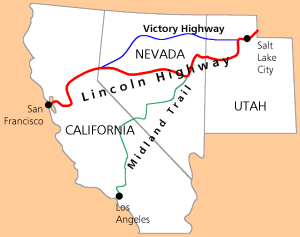

| A Brief History | |
| · | Origins |
| · | Picking a Route |
| · | From Dirt To Concrete |
| · | The End of Named Highways |
| Historic Newspaper Articles | |
| · | Highway Boosters Will Gather Tonight San Francisco Chronicle; October 31, 1913 |
| · | Public To See Dedication of Great Highway San Francisco Examiner; October 31, 1913 |
| · | Plans for Local Demonstration Under Way San Francisco Chronicle; October 26, 1913 |
|
|
The End of Named Highways |
The Lincoln Highway Association set up a system of "consuls" along the highway who would act as local ambassadors. They would represent the highway in local affairs, assist visitors, and let the headquarters know of matters concerning the highway.
However, in 1914, there wasn't much of a highway to be concerned about. No improvements had been made to the Lincoln Highway, and with Ford's refusal to chip in and growing disinterest of people left off the route, the ten-million-dollar fund that Fisher had set up had stalled at the halfway point. Joy decided to abandon the fund and instead redirect the association to a new goal: educating the country for the need for good roads made of concrete, with an improved Lincoln Highway as an example. It would oversee the construction of concrete "seedling miles" way out in the countryside to emphasize the superiority of concrete over unimproved dirt. As people would learn about concrete, they would press the government to construct good roads throughout their state.

Over the next several years, some kinks in the highway were
straightened out. A section in Ohio that ran through Marion, Kenton, and
Lima was soon bypassed by a straighter route to the north. Somewhat
insulted at being left off the Lincoln Highway, the citizens of those
towns claimed the southern route as the Harding Highway, after hometown
hero President Warren Harding. A route through Fort Wayne, South Bend, and
Valparaiso in Indiana was bypassed by a straighter route to the
south.

In the deserts of Utah, west of Salt Lake City, a new route called the Goodyear Cutoff was surveyed and prepared for construction. However, Utah did not want this part of the Lincoln Highway finished. By improving the Arrowhead Route to Los Angeles, travelers, and their money, were kept in the state for hundreds of more miles. The Utah state government promoted a route directly west of Salt Lake City to Wendover, Nevada as the route to San Francisco. This route crossed miles of salt desert, which was often submerged under water. To improve the Wendover road would take much more money than improving the Lincoln Highway.
In 1921, the federal government passed the Federal Highway Act of 1921. Like a similar act passed in 1916, it provided $75 million of matching funds to the states for highway construction. However, unlike the 1916 act, the 1921 act required the states to identify 7 percent of its total mileage was "primary"; only these roads would be eligible for federal funds.
In most states in which it ran, the Lincoln Highway was the obvious choice as a federal road, but there were a few exceptions. The Harding Highway in Ohio lobbied heavily and was improved at the expense of the Lincoln. However, the biggest challenge was in Utah.
The Wendover route was still favored by Utah, and now it was part of
another named highway: the Victory Highway. Like the Lincoln, it claimed
New York and San Francisco as its endpoints, but it claimed the Wendover
road and the route along the Humboldt River in Nevada, which pitted it
directly against the Lincoln. It was virtually unknown in the east but
was favored in Utah, Nevada, and northern California.
 Like their fellow
Utah citizens, northern Californians favored the Victory for economic
reasons: travelers along the Victory would almost certainly go to San
Francisco. If travelers took the Lincoln through western Utah, they could
easily go drive southwest towards Los Angeles, as it was about as far away
as San Francisco.
Like their fellow
Utah citizens, northern Californians favored the Victory for economic
reasons: travelers along the Victory would almost certainly go to San
Francisco. If travelers took the Lincoln through western Utah, they could
easily go drive southwest towards Los Angeles, as it was about as far away
as San Francisco.
Despite numerous reports and heavy lobbying by the Lincoln Highway Association, the federal government selected the Wendover route as the federal road. Consequently, the Victory was also declared the federal road in Nevada. The Goodyear Cutoff, which was never finished by Utah's government, would remain unimproved.
|
|
The End of Named Highways |
Last modified on October 7, 1998